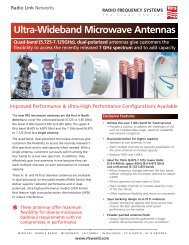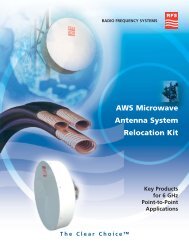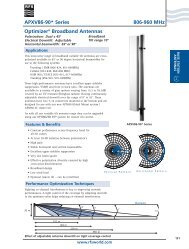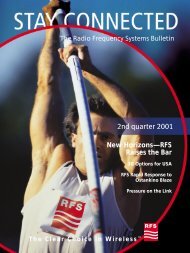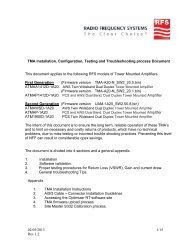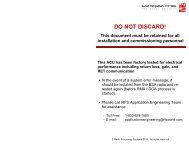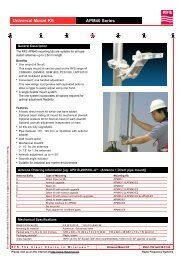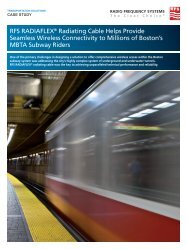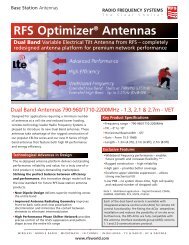download - Radio Frequency Systems
download - Radio Frequency Systems
download - Radio Frequency Systems
Create successful ePaper yourself
Turn your PDF publications into a flip-book with our unique Google optimized e-Paper software.
NPSPAC public safety band will be<br />
relocated to the lower end of the band<br />
(transmitting 851 to 854 MHz), with all<br />
other public safety channels, non-cellular<br />
SMR and B/ILT services relocated (if necessary)<br />
to 854 to 860 MHz. All commercial<br />
cellular-like mobile radio services will be<br />
assigned contiguous spectrum between 862<br />
and 869 MHz, with the spectrum between<br />
860 and 862 MHz reserved as a 1-MHz<br />
expansion band and 1-MHz guard band.<br />
Short-term strategies<br />
By the time the staged rebanding project is<br />
completed sometime in 2008, it should<br />
have virtually eliminated the interference<br />
threat to public safety communications.<br />
However, there are advanced filtering<br />
technologies that can be deployed in the<br />
meantime—and in some cases have already<br />
been deployed—to minimize interference<br />
in the short-term.<br />
The ongoing challenge with RF filtering<br />
14 RF CONDITIONING<br />
in this band is due to the interleaved<br />
spectrum. Public safety receiver bandpass<br />
filters must pass all frequencies between<br />
851 to 869 MHz, including those of<br />
high-power commercial carriers operating<br />
in the same block of spectrum. The same is<br />
true for transmitter filtering: all potential<br />
channels within a certain bandwidth must<br />
be passed. It is impossible to limit the<br />
out-of-band emissions of high-power<br />
signals on a channel-by-channel basis in<br />
this interleaved scenario.<br />
It is possible, however, to apply RF filtering<br />
to groups of contiguous channels, as<br />
Figure 2.<br />
Configuration of US 800-MHz spectrum after rebanding.<br />
permitted by the spectrum allocations of<br />
a particular site. Most sites utilize RF<br />
combining technology in order for multiple<br />
channels to be broadcast from a single<br />
antenna. In practice, each channel enters a<br />
separate resonating chamber (or cavity)<br />
tuned to that channel, and on exiting the<br />
cavity is coupled to the signals of other<br />
channels. The resulting wideband signal<br />
emitted from the combiner typically comprises<br />
six or more channels; this signal is then<br />
directed to the antenna for transmission.<br />
As technology has advanced, these<br />
combiners have grown more sophisticated,<br />
and now also incorporate advanced<br />
filtering technology within the cavity. In<br />
particular, autotune combiners have been<br />
deployed at many commercial mobile radio<br />
transmission sites. Although the autotune<br />
combiner’s primary function is to<br />
continuously monitor and adjust tuning<br />
to accommodate changes in carrier<br />
frequency and environment, the RF filtering<br />
aspect has become increasingly important.<br />
For example, the four-channel ‘Quad’<br />
radios used by many iDEN carriers can<br />
provide a combined output of four<br />
contiguous 25-kHz channels; this 100-kHz<br />
bandwidth corresponds to the bandwidth<br />
of a typical autotune combiner filtering<br />
cavity. Consequently, each group of four<br />
contiguous 25-kHz channels is filtered<br />
during the combining process to<br />
minimize out-of-band emissions, and<br />
hence interference with public safety<br />
channels. The high filtering performance<br />
achieved by autotune combiners is the<br />
result of special dielectric-loaded filter<br />
cavities that provide a high ‘Q’ or quality of<br />
cavity response. The frequency spacing<br />
between autotune combiner cavities is<br />
typically 150 kHz.<br />
Another victim of interference in the<br />
current 800-MHz configuration is the<br />
commercial Cellular B’ receive band, which<br />
ends at 849 MHz. Base station receivers can<br />
be affected on the uplink in much the same<br />
manner as the receivers of portable<br />
radios—in other words, they are subject to<br />
receiver desensitization due to spurious<br />
emissions or blocking from commercial<br />
mobile radio signals close to 851 MHz.<br />
In such cases, installation of a bandpass<br />
filter in the interfering downlink to filter<br />
out-of-band emissions below 851 MHz can<br />
reduce by more than 50 dB the magnitude<br />
of wideband noise received by the affected<br />
base station at 849 MHz or below.<br />
Similarly, installation of a bandpass filter<br />
in the uplink of the affected base station<br />
mitigates the real power of the interferer<br />
falling just outside the affected receive<br />
band. Depending on the transmitting<br />
power of the interfering base station, these<br />
uplink filters need to achieve a minimum<br />
selectivity of up to 50 dB—particularly in<br />
co-location scenarios.<br />
Safety spectrum separated<br />
The interference situation in the USA after<br />
the rebanding of 800-MHz spectrum will<br />
be entirely different—and more easily<br />
controlled. Most significantly, public safety<br />
spectrum will be completely separate from<br />
that allocated to commercial mobile radio<br />
services (operating in the ESMR band—<br />
Figure 2), virtually eliminating interference<br />
between the two.<br />
In the case of public safety communications,<br />
the only remaining interference issue<br />
will be the somewhat unpredictable impact<br />
of transmitter intermodulation. This occurs<br />
when a non-linear combination of two<br />
high-power transmitted signals—such as<br />
an iDEN signal combined with a Cellular<br />
CDMA signal—generate out-of-band<br />
emissions that can fall anywhere in the<br />
spectrum. Because of the high transmitted<br />
powers involved, intermodulation products<br />
of a relatively high order may have<br />
sufficient power to interfere with public



